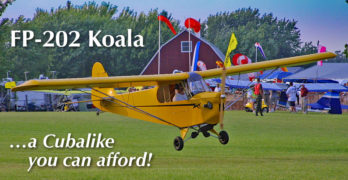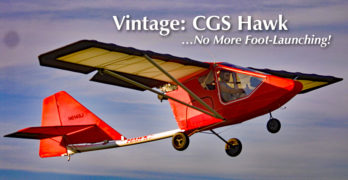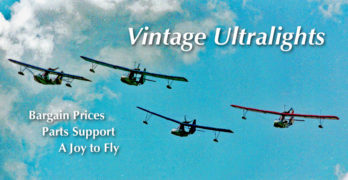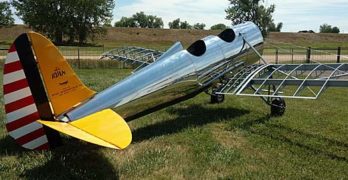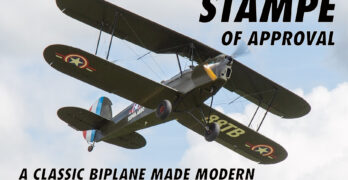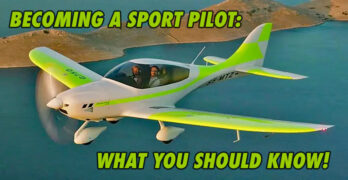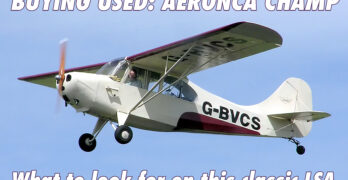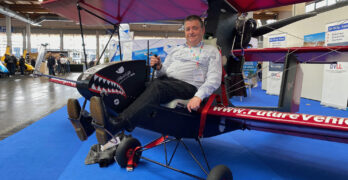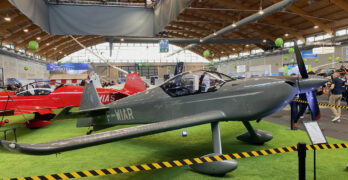When Fisher was still located where it began, in North Dakota, I paid a visit to the factory. It may have been the tidiest wood shop I have ever seen.
I had just written an article about kit-builder assembly manuals so I was keen to see examples of Fisher Flying Products full-size plans. That always sounded like a marketing term yet I knew it meant exactly what they called it.
Darlene Hansen showed me a neatly-organized series of boxes full of long tubes of paper. She took one out, for the fuselage of the Koala as it turned out (see nearby image). She went to one end of a long, flat table and briskly unfurled the tube of paper while hanging on to the loose edge. It rolled and rolled …and rolled, until a sheet about four feet wide and 20 feet long covered the work table.
You literally take the tiny wood pieces Fisher ships to you as part of the kit and lay them directly on the paper as shown.
Search Results for : vintage
Not finding exactly what you expected? Try our advanced search option.
Select a manufacturer to go straight to all our content about that manufacturer.
Select an aircraft model to go straight to all our content about that model.
Ultralight April 2020 — Second in the Vintage Series: CGS Hawk
Way back when, long before the birth of the Light-Sport Aircraft segment (in 2004), lots of us flew ultralights. They were barely more than powered hang gliders — except one.
Before 1982 these lightest-of-all aircraft were required to be foot-launchable. It’s true. I once staggered into the air partly carrying, partly dragging a Quicksilver. I got airborne thanks to a generous 15 mph headwind that provided about three quarters of the speed I needed for… um, you can’t call it “rotation,” but to get enough lift that I could sit down.
Yes, “sit down.” You didn’t think I ran for take off while sitting comfortably belted into a secure seat did you? Nope, that Quicksilver had a literal swing seat and a special rear axle that allowed a full stride of your legs.
OK, that requirement proved futile and FAA later dropped it, but one guy in particular drove that older requirement into the annals of history.
Ultralight April 2020 — First in the Vintage Series: Buccaneer XA
A frequent comment I hear is that the price of recreational aircraft are too high. Some pilots have been stating this for 18 years, since a couple years before Light-Sport Aircraft emerged.
Back in 2002, many believed that the new LSA-to-come would cost $50-60,000. Right or wrong (about those price guesstimates), that range today would be $72-87,000, after correcting for the decline in the dollar’s purchasing power. The truth is that you do have some new choices at that price point but for many, such a cost remains out of their budget for any recreational vehicle, airborne or otherwise.
To those pilots, I often suggest a good, used aircraft and we have more such LSA every year, many of which are excellent buys. Yet, how about we drop down the price further?
How About a Used
Part 103 Ultralight?
Long before LSA were introduced, I flew a single-place Buccaneer with a Rotax 377.
Gorgeous Ryan ST in 95% Replica Form — Vintage Aircraft Lovers’ Delight
One aircraft at EAA AirVenture Oshkosh really caught my eye. OK, truth be told, dozens of aircraft caught my eye but this shiny example seemed to be looking back at me.
We simply had to do a video interview with the developer of the 1930s-era Ryan ST because of its fascinating history and its handsome good looks. If you love vintage aviation, this should grab your attention as it did mine.
Nick Pfannenstiel is a young developer with a mission, to create or, more accurately, re-create the Ryan ST. He began the design phase of his 95% scale Ryan ST in June 2015 and construction began in early 2016. By 2018, you see the aircraft is nearly finished form.
Ryan’s ST featured two open cockpits in tandem seating with a semi-monocoque metal fuselage. A main steel ring forms the backbone of the Ryan ST replica but most of the fuselage uses aluminium alloy
The project is not merely a personal fascination for Nick.
Flying the Stampe SV4-RS — Your Modern Biplane
I’d seen the full-size Stampe SV4-RS replica at AERO a few weeks previously, and it really put a hook in me. I was fortunate enough to fly a Stampe several years ago and was very impressed—it being greatly superior to the DH Tiger Moth, with which it is often confused. Of course, even the youngest Stampe is still 69 years old, and they require a lot of maintenance. Spares for the original Renault engine in particular are getting rare, the strength of the wooden fuselage can be compromised from decades of oil being splattered across it and the metal fixtures and fittings are far from the first flush of youth. These are old aircraft and they require a lot of looking after. Indeed, the reason why such aircraft (and cars and motorbikes of a similar vintage) are often referred to as “collector’s machines” is that you often need someone following along behind collecting up all the pieces that have fallen off!
Buying Used: The Ercoupe — We Don’t Need No Stinkin’ Pedals
Few legacy GA aircraft are as easily recognizable as the Ercoupe. The twin tails and large glazed canopy are distinctive, as are its lack of rudder pedals (on most models). Ercoupe Owner’s Club Executive Director Gene Bunt says, “for lack of a better explanation…it’s got major ‘cute factor’.” But apart from its unique looks, the plane is also known for being easy to fly. It was, after all, designed with the goal of being the safest fixed wing aircraft available—one that would not stall or spin.
While the Ercoupe is a type certified aircraft, many of the variants qualify within the Light Sport category. When MOSAIC comes in all of them will qualify. That’s great news for Sport Pilots looking for something “different” to fly. And, they regularly show up for sale for comparatively little money.
Development
Fred Weick, an aeronautical engineer who would later create the Piper Pawnee and have a hand in designing the Piper Cherokee, designed the Ercoupe after joining the newly formed Engineering and Research Corporation (ERCO) in 1936.
Sport Pilot Certificate – What You Need to Know
The Sport Pilot Certificate has emerged as a popular option for aspiring pilots who want to experience the joy of recreational flying without the extensive time and financial commitment required for a Private Pilot Certificate. It’s been with us for two decades but there are still questions about the SP certificate. Here’s a rundown.
There are seven main categories of aircraft for which you can be a Sport Pilot, each with variations on training and pilot requirements specific to that Category. This article will be specific to the Airplane Category.
What is the Sport Pilot Certificate?
The Sport Pilot Certificate allows pilots to fly a Light Sport Aircraft (LSA). These aircraft are typically smaller, simpler and more affordable to operate. Key characteristics of LSAs include:
Maximum takeoff weight of 1320 pounds (or 1430 for seaplanes)
Maximum airspeed in level flight of 120 knots under standard atmospheric conditions
Maximum stall speed of 45 knots in landing configuration
Single, non-turbine engine
Fixed pitch or ground adjustable propeller
Fixed landing gear (except for seaplanes)
Note that all of these are under the current LSA/SP rules and are likely to change when MOSAIC becomes reality next year.
Buying Used: Aeronca Champ—A Plane That Deserves Your Respect
The Aeronca Champion might be the Rodney Dangerfield of light aircraft. The plane, which has historically played second fiddle to the Piper Cub, doesn’t get the respect it deserves, according to its fans. “Take all the light planes from that era and look at which offers the best characteristics… I would place the Champ at the top,” argues John Weigel, a Boston area pilot who twice flew a Champ from coast to coast. “I love the Cub,” he says, “but the Champ has no bad qualities. And if I’m taking someone up with me, I’ll take it over other similar planes every time.”
When compared to the Cub, as well as the Luscombe, Taylorcraft and Cessna 120 and 140, among other tailwheelers, the Champ is easier to get into, offers more comfort, has better visibility, more forgiving landing gear and is probably the better training/low-time pilot aircraft. All are good reasons to consider a Champ if you’re looking for a simple, relatively inexpensive and fun to fly aircraft.
AERO Wrapup: Dave Unwin Concludes His Coverage of AERO Friedrichshafen 2024
With my feet failing fast, and the lederhosen beginning to chafe in a most disagreeable fashion, I viewed the end of AERO 2024 with mixed emotions. My legs said enough is enough, but my head, heart and eyes still wanted more—because what a show it was! From replica rocket-powered fighters to jet packs, LSAs fitted with turbines and paramotors for paraplegics and finally to biplane pusher SSDRs, it was a fabulous event.
The AERO team produced a show that they could justifiably be proud of for the 30th anniversary, and although the weather was unseasonably cool, the action in the halls was as hot as ever, and with more than 270 aircraft in the exhibition halls and in the static display, show-goers were not short of mouth-watering machines to tempt their wallets.
Among the aircraft debuting at the show were the electric DA40 aircraft from Diamond Aircraft in Austria, two electric aircraft and a hydrogen powered one from China and the Integral E from French manufacturer Aura Aero.
Day 1 at AERO: Affordable Aviation at Friedrichshafen
Editor’s Note: Correspondent Dave Unwin is at the AERO show in Friedrichshafen, Germany, this week and will be reporting on news from the show. Here’s his first report.
Europe’s top general aviation event, AERO at Friedrichshafen, Germany opened on Wednesday, April 17, and runs through Sunday. It is no exaggeration to say that AERO has grown to become one of the biggest and best GA events on the planet—and certainly the biggest outside of North America.
This year is the 30th time the event has been staged and the organizers claim that more than 680 exhibitors from 36 countries are attending, which may well make the 2024 AERO the biggest ever.
The amount and diversity of aircraft on display was truly breathtaking, from a full-scale Me163 replica, powered by a small jet engine typically fitted to self-sustaining sailplanes, to the very latest bizjets. Unsurprisingly, there were several electric aircraft on display, and Bristell—in partnership with H55—had flown its final prototype of the electric Bristell B23 Energic to the show.
- « Previous Page
- 1
- 2
- 3
- 4
- …
- 12
- Next Page »


